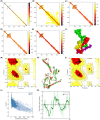Epitope screening and vaccine molecule design of PRRSV GP3 and GP5 protein based on immunoinformatics
- PMID: 38217314
- PMCID: PMC10844699
- DOI: 10.1111/jcmm.18103
Epitope screening and vaccine molecule design of PRRSV GP3 and GP5 protein based on immunoinformatics
Abstract
Porcine reproductive and respiratory syndrome (PRRS) is a respiratory disease in pigs that causes severe economic losses. Currently, live PRRSV vaccines are commonly used but fail to prevent PRRS outbreaks and reinfection. Inactivated PRRSV vaccines have poor immunogenicity, making PRRSV a significant threat to swine health globally. Therefore, there is an urgent need to develop an effective PRRSV vaccine. This study used immunoinformatics to predict, screen, design and construct a candidate vaccine that fused B-cell epitopes, CTL- and HTL-dominant protective epitopes of PRRSV strain's GP3 and GP5 proteins. The study identified 12 B-cell epitopes, 6 CTL epitopes and 5 HTL epitopes of GP3 and GP5 proteins. The candidate vaccine was constructed with 50S ribosomal protein L7/L1 molecular adjuvant, which has antigenicity, solubility, stability, non-allergenicity and a high affinity for its target receptor, TLR-3. The C-ImmSim immunostimulation results showed significant increases in cellular and humoral responses (B cells and T cells) and production of TGF-β, IL-2, IL-10, IFN-γ and IL-12. The constructed vaccine was stable and immunogenic, and it can effectively induce strong T-cell and B-cell immune responses against PRRSV. Therefore, it is a promising candidate vaccine for controlling and preventing PRRSV outbreaks.
Keywords: GP3; GP5; immunoinformatics; porcine reproductive and respiratory syndrome virus; vaccine candidate.
© 2024 The Authors. Journal of Cellular and Molecular Medicine published by Foundation for Cellular and Molecular Medicine and John Wiley & Sons Ltd.
Conflict of interest statement
The authors declare no conflict of interest.
Figures








Similar articles
-
Replacing the decoy epitope of PCV2 capsid protein with epitopes of GP3 and/or GP5 of PRRSV enhances the immunogenicity of bivalent vaccines in mice.J Virol Methods. 2020 Oct;284:113928. doi: 10.1016/j.jviromet.2020.113928. Epub 2020 Jul 7. J Virol Methods. 2020. PMID: 32650038
-
In silico design of multi-epitope vaccine candidate based on structural proteins of porcine reproductive and respiratory syndrome virus.Vet Immunol Immunopathol. 2025 Feb;280:110881. doi: 10.1016/j.vetimm.2025.110881. Epub 2025 Jan 5. Vet Immunol Immunopathol. 2025. PMID: 39847849
-
Construction and immunogenicity of a DNA vaccine coexpressing GP3 and GP5 of genotype-I porcine reproductive and respiratory syndrome virus.BMC Vet Res. 2014 Jun 10;10:128. doi: 10.1186/1746-6148-10-128. BMC Vet Res. 2014. PMID: 24916952 Free PMC article.
-
Innate and adaptive immunity against Porcine Reproductive and Respiratory Syndrome Virus.Vet Immunol Immunopathol. 2015 Sep 15;167(1-2):1-14. doi: 10.1016/j.vetimm.2015.07.003. Epub 2015 Jul 17. Vet Immunol Immunopathol. 2015. PMID: 26209116 Free PMC article. Review.
-
Porcine reproductive and respiratory syndrome virus vaccines: current status and strategies to a universal vaccine.Transbound Emerg Dis. 2014 Apr;61(2):109-20. doi: 10.1111/tbed.12016. Epub 2013 Jan 24. Transbound Emerg Dis. 2014. PMID: 23343057 Review.
Cited by
-
Immune Protection Gap Between Porcine Reproductive and Respiratory Syndrome Subunit Vaccine (N Protein) and Live Vaccine.Vaccines (Basel). 2025 Apr 23;13(5):441. doi: 10.3390/vaccines13050441. Vaccines (Basel). 2025. PMID: 40432053 Free PMC article.
-
In Silico Designed Multi-Epitope Vaccine Based on the Conserved Fragments in Viral Proteins for Broad-Spectrum Protection Against Porcine Reproductive and Respiratory Syndrome Virus.Vet Sci. 2025 Jun 12;12(6):577. doi: 10.3390/vetsci12060577. Vet Sci. 2025. PMID: 40559814 Free PMC article.
-
Current Status of Porcine Reproductive and Respiratory Syndrome Vaccines.Vaccines (Basel). 2024 Dec 10;12(12):1387. doi: 10.3390/vaccines12121387. Vaccines (Basel). 2024. PMID: 39772049 Free PMC article. Review.
-
A Novel Peptide-Based Enzyme-Linked Immunosorbent Assay (ELISA) for Detection of Neutralizing Antibodies Against NADC30-like PRRSV GP5 Protein.Int J Mol Sci. 2025 Mar 14;26(6):2619. doi: 10.3390/ijms26062619. Int J Mol Sci. 2025. PMID: 40141266 Free PMC article.
-
Design of a Multiepitope Pan-Proteomic mRNA Vaccine Construct Against African Swine Fever Virus: A Reverse Vaccinology Approach.Vet Med Int. 2025 Jan 4;2025:2638167. doi: 10.1155/vmi/2638167. eCollection 2025. Vet Med Int. 2025. PMID: 39803351 Free PMC article.
References
-
- Thanawongnuwech R, Suradhat S. Taming PRRSV: revisiting the control strategies and vaccine design. Virus Res. 2010;154:133‐140. - PubMed
-
- Paton DJ, Brown IH, Edwards S. 'Blue ear' disease of pigs. Vet Rec. 1991;128:617. - PubMed
-
- Zhou L, Yang H. Porcine reproductive and respiratory syndrome in China. Virus Res. 2010;154:31‐37. - PubMed
Publication types
MeSH terms
Substances
Grants and funding
- LBH-Z21074/Heilongjiang Postdoctoral project
- XYB202012/Heilongjiang Bayi Agricultural University, academic success, introduction of talents scientific research start-up plan project
- XYB202206/Heilongjiang Bayi Agricultural University, academic success, introduction of talents scientific research start-up plan project
LinkOut - more resources
Full Text Sources
Medical
Miscellaneous

